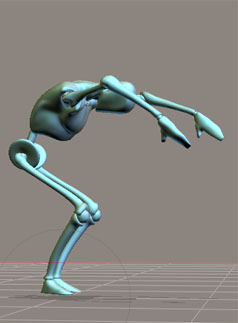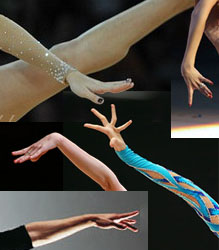General
A rhythmic gymnasts is expected to pay attention to all these little details that can affect the artistic impression and execution marks:
 Head and neck - the head and neck should participate in the movements, especially in body wave and some of the wrap/tuck positions. Most of time, the neck should be extended, the chin held high up with the eyes still looking forward. Tiny tilts of the head and neck when appropriate adds to the artistic expression.
Head and neck - the head and neck should participate in the movements, especially in body wave and some of the wrap/tuck positions. Most of time, the neck should be extended, the chin held high up with the eyes still looking forward. Tiny tilts of the head and neck when appropriate adds to the artistic expression.
- Shoulders and chest - Unless intended, shoulders should be pulled back and sitting low. It may be easy to do in static poses, often lack of strength in the lower body can trigger the shoulder to compensate the lack of a 'lift' as commonly seen in chasse, leaps and jumps. (Apparatus errors can result from this use of the upper body and arms as well).
 Arms (elbows, hand to fingers) - Unless intended to be bent or rounded, extension of the arms must go right through the elbows to the hands and through the finger tips.
Arms (elbows, hand to fingers) - Unless intended to be bent or rounded, extension of the arms must go right through the elbows to the hands and through the finger tips.
- Body and back - .
- Legs (from hip through knees to feet and toes) - .
- Face and eyes - Show judges your personality. After sitting through the same routine over and over again, someone who is vibrant and enjoying themselves and will impress.
As coaches, we often remind the gymnasts about 'the smile'. However, smiles are better taught as a "state of mind" or "a feeling" and not just a muscle movement. Create that 'happy' atmosphere and state of mind right from the warm up and especially when the music starts and the smile will come automatically.
Technical Body Skills
- Jumps and leaps - must have elevation / height and must show a definitive shape of the difficulty.
Tips to land light: Learn to jump high and yet land light is very important to protect the gymnasts knees and feet. To land light, land on the ball of the feet and absorb the force of the landing. I would almost put this in importance before jumping high.
- Balances - must pause and hold and must show the required shape of the difficulty
Tips to stablize: Common error is to look at the floor. Do pick a spot that is at eye level from slightly far away. Focus on strong ankles and toes, squeeze the thigh and muscles around the knee and feel a tight tummy and relax the shoulders.
- Pivots - must hold the shape for the 'entire' turn on toes.
- Flexibilities and waves - must display the range of motion required for the specific difficulty. For waves, must show the correctly coordinated and sequenced set of body motion with participation of the head and neck.